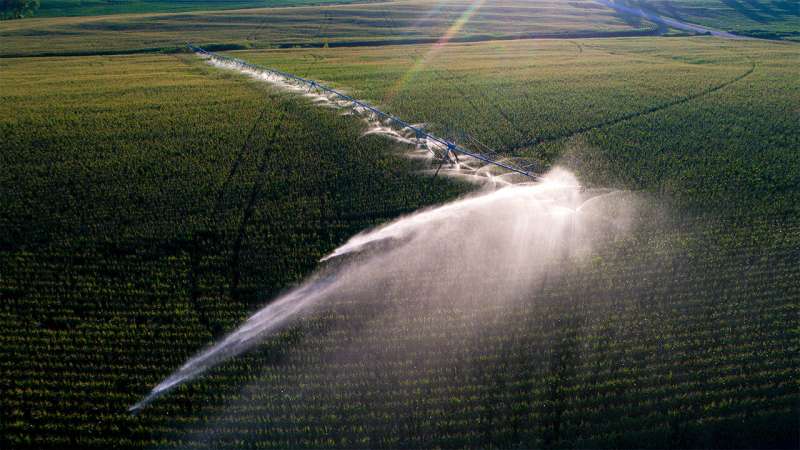

Photo: A center-pivot irrigation system waters a cornfield near Adams, Nebraska, about 45 minutes south of Lincoln. A new Husker-led study shows how the depletion of groundwater—the same that many farmers rely on for irrigation—can threaten food production amid drought and drier climes. Due in part to the challenges of extracting groundwater, an aquifer’s depletion can curb crop yields even when it appears saturated enough to continue meeting the demands of irrigation, the study found. Credit: Craig Chandler, University of Nebraska–Lincoln
Three decades of data have informed a new Nebraska-led study that shows how the depletion of groundwater—the same that many farmers rely on for irrigation—can threaten food production amid drought and drier climes.
The study found that, due in part to the challenges of extracting groundwater, an aquifer’s depletion can curb crop yields even when it appears saturated enough to continue meeting the demands of irrigation. Those agricultural losses escalate as an aquifer dwindles, the researchers reported, so that its depletion exerts a greater toll on corn and soybean yields when waning from, say, 100 feet thick to 50 than from 200 feet to 150.
That reality should encourage policymakers, resource managers, and growers to reconsider the volume of crop-quenching groundwater they have at their disposal, the team said, especially in the face of fiercer, more frequent drought.
“As you draw down an aquifer to the point that it’s quite thin, very small changes in the aquifer thickness will then have progressively larger and larger impacts on your crop production and resilience,” said Nick Brozović, director of policy at the Daugherty Water for Food Global Institute. “And that’s a thing that we don’t predict well because we tend to predict based on the past. So if we base what’s going to happen on our past experience, we’re always going to underpredict. We’re always going to be surprised by how bad things get.”
The team came to its conclusions after analyzing yields, weather, and groundwater data from the High Plains Aquifer, which, as the largest in the United States, underlies portions of eight states—including nearly all of Nebraska. Some areas of the aquifer, especially those beneath Texas and Kansas but also the Cornhusker State, have diminished considerably over the past several decades, pumped for the sake of irrigating land that would otherwise stand little chance of sustaining crops.
“In terms of things that let you address food security under extreme conditions—in particular, drought and climate change—we really can’t do without irrigation,” said Brozović, professor of agricultural economics at the University of Nebraska–Lincoln. “If we want to feed the world with high-quality, nutritious food and a stable food supply, we need to irrigate.”
Brozović and Husker colleague Taro Mieno had already constructed […]
Full article: phys.org
Clean water is essential for life, yet millions of Americans unknowingly consume contaminants through their…
Human brains contain higher concentrations of microplastics than other organs, according to a new study, and the…
From the Office of the Governor: In anticipation of a multi-day, significant atmospheric river in Northern California,…
From Governor Newsom: Scientists, water managers, state leaders, and experts throughout the state are calling…
Photo: A harmful algal bloom in Milford Lake, Kansas, made the water appear bright green.…
An expanded plastic foam coffee cup is at a donut shop in Monterey Park, California.…